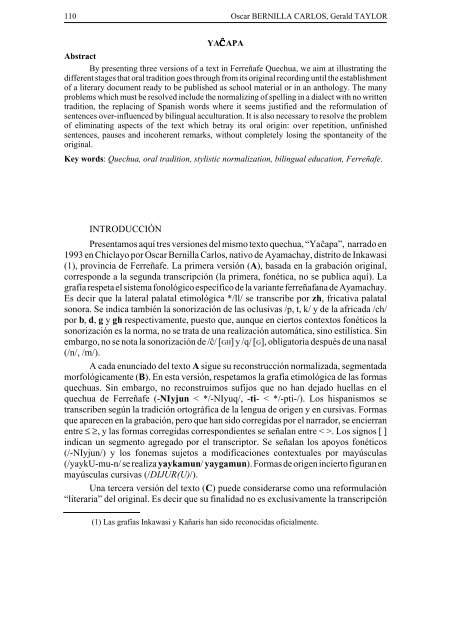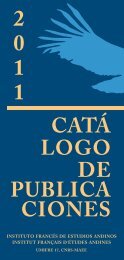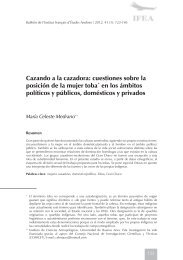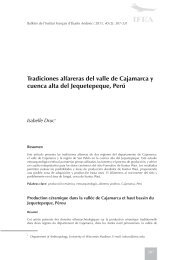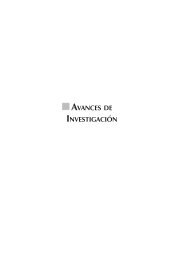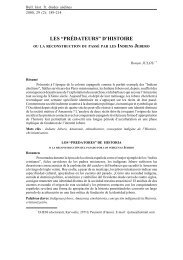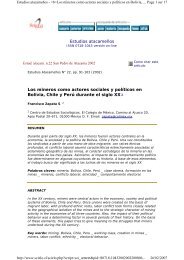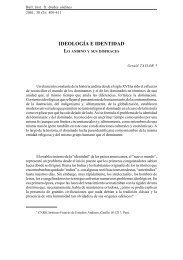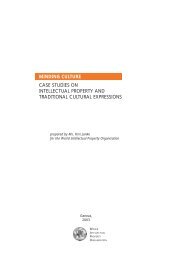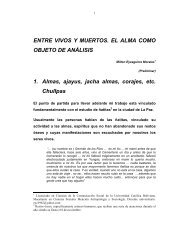¡Texto completo! - Instituto Francés de Estudios Andinos
¡Texto completo! - Instituto Francés de Estudios Andinos
¡Texto completo! - Instituto Francés de Estudios Andinos
Create successful ePaper yourself
Turn your PDF publications into a flip-book with our unique Google optimized e-Paper software.
110 Oscar BERNILLA CARLOS, Gerald TAYLOR<br />
YA¢APA<br />
Abstract<br />
By presenting three versions of a text in Ferreñafe Quechua, we aim at illustrating the<br />
different stages that oral tradition goes through from its original recording until the establishment<br />
of a literary document ready to be published as school material or in an anthology. The many<br />
problems which must be resolved inclu<strong>de</strong> the normalizing of spelling in a dialect with no written<br />
tradition, the replacing of Spanish words where it seems justified and the reformulation of<br />
sentences over-influenced by bilingual acculturation. It is also necessary to resolve the problem<br />
of eliminating aspects of the text which betray its oral origin: over repetition, unfinished<br />
sentences, pauses and incoherent remarks, without completely losing the spontaneity of the<br />
original.<br />
Key words: Quechua, oral tradition, stylistic normalization, bilingual education, Ferreñafe.<br />
INTRODUCCIÓN<br />
Presentamos aquí tres versiones <strong>de</strong>l mismo texto quechua, “Ya©apa”, narrado en<br />
1993 en Chiclayo por Oscar Bernilla Carlos, nativo <strong>de</strong> Ayamachay, distrito <strong>de</strong> Inkawasi<br />
(1), provincia <strong>de</strong> Ferreñafe. La primera versión (A), basada en la grabación original,<br />
correspon<strong>de</strong> a la segunda transcripción (la primera, fonética, no se publica aquí). La<br />
grafía respeta el sistema fonológico específico <strong>de</strong> la variante ferreñafana <strong>de</strong> Ayamachay.<br />
Es <strong>de</strong>cir que la lateral palatal etimológica */ll/ se transcribe por zh, fricativa palatal<br />
sonora. Se indica también la sonorización <strong>de</strong> las oclusivas /p, t, k/ y <strong>de</strong> la africada /ch/<br />
por b, d, g y gh respectivamente, puesto que, aunque en ciertos contextos fonéticos la<br />
sonorización es la norma, no se trata <strong>de</strong> una realización automática, sino estilística. Sin<br />
embargo, no se nota la sonorización <strong>de</strong> /©/ [GH] y /q/ [G], obligatoria <strong>de</strong>spués <strong>de</strong> una nasal<br />
(/n/, /m/).<br />
A cada enunciado <strong>de</strong>l texto A sigue su reconstrucción normalizada, segmentada<br />
morfológicamente (B). En esta versión, respetamos la grafía etimológica <strong>de</strong> las formas<br />
quechuas. Sin embargo, no reconstruimos sufijos que no han <strong>de</strong>jado huellas en el<br />
quechua <strong>de</strong> Ferreñafe (-NIyjun < */-NIyuq/, -ti- < */-pti-/). Los hispanismos se<br />
transcriben según la tradición ortográfica <strong>de</strong> la lengua <strong>de</strong> origen y en cursivas. Formas<br />
que aparecen en la grabación, pero que han sido corregidas por el narrador, se encierran<br />
entre ≤ ≥, y las formas corregidas correspondientes se señalan entre < >. Los signos [ ]<br />
indican un segmento agregado por el transcriptor. Se señalan los apoyos fonéticos<br />
(/-NIyjun/) y los fonemas sujetos a modificaciones contextuales por mayúsculas<br />
(/yaykU-mu-n/ se realiza yaykamun/ yaygamun). Formas <strong>de</strong> origen incierto figuran en<br />
mayúsculas cursivas (/DIJUR(U)/).<br />
Una tercera versión <strong>de</strong>l texto (C) pue<strong>de</strong> consi<strong>de</strong>rarse como una reformulación<br />
“literaria” <strong>de</strong>l original. Es <strong>de</strong>cir que su finalidad no es exclusivamente la transcripción<br />
(1) Las grafías Inkawasi y Kañaris han sido reconocidas oficialmente.


